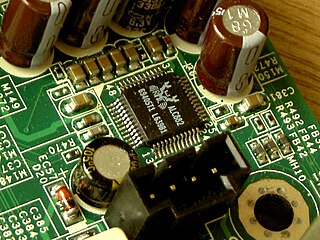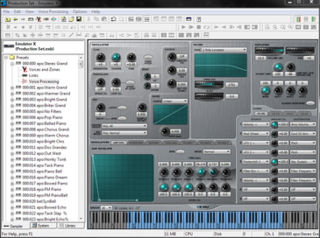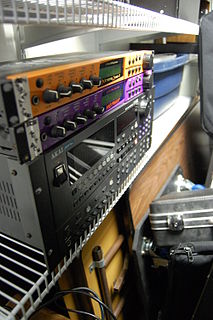Related Research Articles

A sound card is an internal expansion card that provides input and output of audio signals to and from a computer under control of computer programs. The term sound card is also applied to external audio interfaces used for professional audio applications.
A music tracker is a type of music sequencer software for creating music. The music is represented as discrete musical notes positioned in several channels at discrete chronological positions on a vertical timeline. A music tracker's user interface is usually number based. Notes, parameter changes, effects and other commands are entered with the keyboard into a grid of fixed time slots as codes consisting of letters, numbers and hexadecimal digits. Separate patterns have independent timelines; a complete song consists of a master list of repeated patterns.

Sound Blaster is a family of sound cards designed by Singaporean technology company Creative Technology. Sound Blaster sound cards were the de facto standard for consumer audio on the IBM PC compatible system platform, until the widespread transition to Microsoft Windows 95, which standardized the programming interface at application level, and the evolution in PC design led to onboard audio electronics, which commoditized PC audio functionality. By 1995, Sound Blaster cards had sold over 15 million units worldwide and accounted for seven out of ten sound card sales.
Digital waveguide synthesis is the synthesis of audio using a digital waveguide. Digital waveguides are efficient computational models for physical media through which acoustic waves propagate. For this reason, digital waveguides constitute a major part of most modern physical modeling synthesizers.

Pro Tools is a digital audio workstation (DAW) developed and released by Avid Technology for Microsoft Windows and macOS. It is used for music creation and production, sound for picture and, more generally, sound recording, editing, and mastering processes.
The Environmental Audio Extensions are a number of digital signal processing presets for audio, present in Creative Technology Sound Blaster sound cards starting with the Sound Blaster Live and the Creative NOMAD/Creative ZEN product lines. Due to the release of Windows Vista which deprecated the DirectSound3D API EAX was based on in 2007, Creative discouraged EAX implementation in favour of its OpenAL-based EFX equivalent – though at that point relatively few games used the API.
DirectSound is a deprecated software component of the Microsoft DirectX library for the Windows operating system, superseded by XAudio2. It provides a low-latency interface to sound card drivers written for Windows 95 through Windows XP and can handle the mixing and recording of multiple audio streams. DirectSound was originally written for Microsoft by John Miles.
DirectMusic is a deprecated component of the Microsoft DirectX API that allows music and sound effects to be composed and played and provides flexible interactive control over the way they are played. Architecturally, DirectMusic is a high-level set of objects, built on top of DirectSound, that allow the programmer to play sound and music without needing to get quite as low-level as DirectSound. DirectSound allows for the capture and playback of digital sound samples, whereas DirectMusic works with message-based musical data. Music can be synthesized either in hardware, in the Microsoft GS Wavetable SW Synth, or in a custom synthesizer.

Intel High Definition Audio (IHDA) is a specification for the audio sub-system of personal computers. It was released by Intel in 2004 as successor to its AC'97 PC audio standard.

Emulator X is a software-based audio sampler that was produced by E-MU Systems from 2004 to 2009.

The Ensoniq AudioPCI is a PCI-based sound card released in 1997. It was Ensoniq's last sound card product before they were acquired by Creative Technology. The card represented a shift in Ensoniq's market positioning. Whereas the Soundscape line had been made up primarily of low-volume high-end products full of features, the AudioPCI was designed to be a very simple, low-cost product to appeal to system OEMs and thus hopefully sell in mass quantities.
Sound Blaster Live! is a PCI add-on sound card from Creative Technology Limited for PCs. Moving from ISA to PCI allowed the card to dispense with onboard memory, storing digital samples in the computer's main memory and then accessing them in real time over the bus. This allowed for a much wider selection of, and longer playing, samples. It also included higher quality sound output at all levels, quadrophonic output, and a new MIDI synthesizer with 64 sampled voices. The Live! was introduced in August 1998 and variations on the design remained Creative's primary sound card line into the 2000s.

Sound Blaster Audigy is a product line of sound cards from Creative Technology. The flagship model of the Audigy family used the EMU10K2 audio DSP, an improved version of the SB-Live's EMU10K1, while the value/SE editions were built with a less-expensive audio controller.

The Sound Blaster AWE32 is an ISA sound card from Creative Technology. It is an expansion board for PCs and is part of the Sound Blaster family of products. The Sound Blaster AWE32, introduced in March 1994, was a near full-length ISA sound card, measuring 14 inches (356 mm) in length, due to the number of features included.
This article describes audio APIs and components in Microsoft Windows which are now obsolete or deprecated.
Sonar was a digital audio workstation created by the former Boston, Massachusetts-based music production software company Cakewalk. It was acquired by Singaporean music company BandLab Technologies, and renamed Cakewalk by BandLab.
Windows Vista, an operating system released by Microsoft for consumers on January 30, 2007, has been widely criticized by reviewers and users. Due to issues with new security features, performance, driver support and product activation, Windows Vista has been the subject of a number of negative assessments by various groups.
The Protected Media Path is a set of technologies creating a "Protected Environment," first included in Microsoft's Windows Vista operating system, that is used to enforce digital rights management protections on content. Its subsets are Protected Video Path (PVP) and Protected User Mode Audio (PUMA). Any application that uses Protected Media Path in Windows uses Media Foundation.

E-MU Systems was a software synthesizer, audio interface, MIDI interface, and MIDI keyboard manufacturer. Founded in 1971 as a synthesizer maker, E-mu was a pioneer in samplers, sample-based drum machines and low-cost digital sampling music workstations.

The E-mu Proteus was a range of digital sound modules and keyboards manufactured by E-mu Systems in the late twentieth century.
References
- ↑ Bruce McIntyre, E-MU Systems